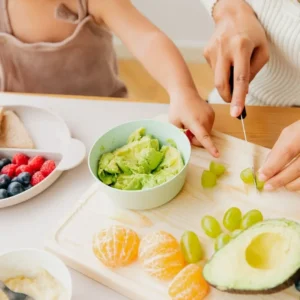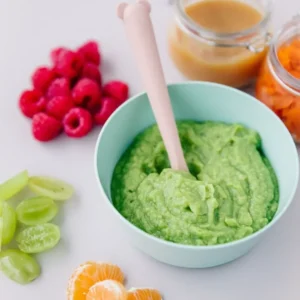
12 month baby food chart | 1 year baby food chart
Weeks 1-2: Introduction of New Foods
>Note: Continue to breastfeed or provide formula as needed.
Day 1-2: Small Pieces of Chapati or Roti
- Tear small, soft pieces of chapati or roti for your baby to hold and chew on. Ensure they are manageable in size.
Day 3-4: Mashed Banana with a Pinch of Cinnamon
- Mash a ripe banana and add a pinch of cinnamon powder for added flavor.
Day 5-6: Cooked and Chopped Sweet Potatoes
- Steam or boil sweet potatoes until they are soft and chop them into small, easy-to-chew pieces.
Weeks 3-4: Expanding the Diet
Day 1-2: Mashed Potatoes with Peas
- Boil and mash potatoes and peas together.
- Day 3-4: Pureed Papaya
- Blend ripe papaya into a smooth puree.
Day 5-6: Soft Idli or Dosa
- Offer small pieces of soft idli or dosa. You can serve them with a mild chutney.
Weeks 5-6: Adding Proteins
Day 1-2: Mashed Moong Dal (Green Gram)
- Cook moong dal until it’s soft and then mash it.
Day 3-4: Scrambled Egg Yolk
- Scramble the yolk of a boiled egg and offer it to your baby.
- Day 5-6: Mashed Rice with Spinach and Paneer
- Cook rice, spinach, and paneer until they’re very soft. Mash them together.
Weeks 7-8: Introducing New Flavors
Day 1-2: Vegetable Upma
- Prepare upma with a bit of ghee and soft, finely chopped vegetables. Ensure it’s not too spicy.
Day 3-4: Tomato Rice
- Cook rice with soft tomatoes and a bit of ghee. Mash them together.
Day 5-6: Avocado Slices
- Cut ripe avocado into small, manageable slices. It’s a healthy source of fats and nutrients.
Weeks 9-10: Transition to Family Foods
Day 1-2: Soft Rice and Dal with Ghee
- Offer a small portion of soft rice and dal, with a little ghee for flavor.
Day 3-4: Cooked Pasta with Veggies
- Cook pasta until it’s soft and toss it with finely chopped, cooked vegetables.
Day 5-6: Mashed Chicken with Soft Vegetables
- Cook chicken until it’s tender, then mash it with steamed or boiled vegetables.

2 years baby food chart
Breakfast Options:
- Oatmeal: Cook oatmeal with milk and add some diced fruits like bananas or berries for extra flavor.
- Scrambled Eggs: Scramble eggs with a little cheese or veggies like bell peppers.
- Whole Wheat Pancakes: Make pancakes using whole wheat flour and top them with yogurt and a drizzle of honey.
- Paratha: Prepare paratha with mashed potatoes or spinach. Serve with yogurt or a small serving of pickle.
Mid-Morning Snack:
- Fruit Slices: Offer a variety of sliced fruits like apples, pears, or watermelons.
Lunch:
- Rice and Dal: Cook rice and dal (lentils) with mild spices and add some cooked vegetables.
- Chapati with Vegetable Curry: Serve chapati with a simple vegetable curry made with carrots, peas, and potatoes.
- Pasta with Tomato Sauce: Cook pasta and top it with a tomato-based sauce and grated cheese.
Afternoon Snack:
- Cheese Slices: Offer small slices of cheese along with a few whole-grain crackers.
- Fruit Smoothie: Blend fruits like banana, mango, or berries with yogurt or milk for a tasty smoothie.
Dinner:
- Khichdi: Make khichdi with rice and lentils, and add some finely chopped vegetables for added nutrition.
- Roti with Paneer and Spinach: Serve roti with paneer (cottage cheese) and spinach curry.
- Veggie Nuggets: Prepare homemade veggie nuggets with mashed vegetables and breadcrumbs.
Bedtime Snack (if needed):
- Sliced Banana: A small serving of sliced banana is a simple and nutritious option.
- Milk: A small glass of warm milk can help your toddler sleep better.
Baby food products
Here are some common and important baby food products:
- Infant Formula: Infant formulas are designed to provide essential nutrients for babies who are not breastfed.
- Baby Cereal: These are often the first solid foods introduced to babies.
- Baby Food Purees: These are available in jars, pouches, or containers and come in various fruit, vegetable, and meat varieties. They are typically used when transitioning to solid foods.
- Baby Snacks: These include teething biscuits, rice puffs, and baby yogurt melts, which are designed to be safe for babies to chew and eat.
- Baby Food Pouches: These convenient pouches contain pureed fruits and vegetables and are easy to carry and use when you’re on the go.
- Baby Rice Cakes: These are easy-to-hold snacks that can be a good option for older babies who are learning to feed themselves.
- Baby Food Mix-Ins: These are products that can be added to a baby’s food to boost nutrition, such as powdered vitamins or probiotics.
- Baby Cereals with Added Iron: These cereals are specially fortified with iron, an essential nutrient for babies.
- Baby Food Cookbooks: These provide recipes and guidance for parents who want to make homemade baby food from scratch.
- Baby Food Storage Containers: These containers are designed to store homemade baby food safely and efficiently.
- Baby Food Feeding Spoons: These spoons are specially designed for feeding babies, with soft tips and shallow scoops to prevent choking.
- Baby Food Warming Bowls: These bowls are designed to heat baby food evenly without hotspots in the microwave.
Gerber baby food
Benefits:
- Nutrient-Rich: Gerber baby foods are formulated to provide essential nutrients that support a baby’s growth and development.
- Convenience: Gerber offers a wide range of baby food options in convenient packaging, including jars, pouches, and containers. This makes feeding on the go or while traveling easier for parents.
- Age-Appropriate: Gerber categorizes its products by age and developmental stage, ensuring that babies receive appropriate nutrients as they grow.
- Safety Standards: Gerber follows rigorous safety and quality control measures to ensure that its baby food products are safe for consumption.
Side Effects:
- Potential Allergens: Some Gerber baby food products contain common allergens like dairy, wheat, and soy.
- Texture Concerns: Some parents find that the texture of commercial baby foods, including Gerber products, can be smoother and less textured than homemade baby food.
- Overreliance: Relying solely on commercial baby food products may discourage parents from introducing fresh, homemade foods to their babies.
- Packaging and Sustainability: Single-use packaging, such as pouches and jars, can contribute to plastic waste
- Price: Commercial baby food, including Gerber, can be more expensive than making homemade baby food from fresh ingredients.

Homemade baby food | organic baby food
Homemade Baby Food:
- Freshness and Quality: You control the ingredients’ quality and freshness.
- Customization: Tailor meals to your baby’s preferences and needs.
- Transparency: Know exactly what’s in your baby’s food.
- Cost-Efficient: Often more budget-friendly.
- Reduced Environmental Impact: Reduces single-use packaging.
Organic Baby Food:
- Minimal Pesticides and Chemicals: Made from pesticide-free ingredients.
- Nutrient Density: May have higher nutrient levels.
- Ethical and Environmental Considerations: Supports sustainable farming and ethical practices.
- Fewer Additives: Contains fewer artificial additives.
- Allergen Minimization: May have fewer allergenic additives.
Can I stop breastfeeding before the age of 6th month?
No, You can’t stop breastfeeding before the age of six months at least.
A Complete Guide to Healthy Baby Food Recipes 2023

0 to 3 Months Baby Food Chart 0 to 6 months baby food chart 4 months baby food chart India 5 months baby food chart for Indian 6-month baby food chart/menu/recipes 7 months baby food chart for Indian 8-month baby food chart for weight gain 9-month-old baby food chart 10-month-old baby food chart 11 month baby food chart 12 month baby food chart | 1 year baby food chart 2 years baby food chart Baby food products Gerber baby food Homemade baby food | organic baby food
Type: Baby Food
Cuisine: Indian
Keywords: Healthy Baby Food
Recipe Yield: Verious
Calories: Verious
Preparation Time: 30M
Cooking Time: 30M
Total Time: 1H
Recipe Ingredients:
